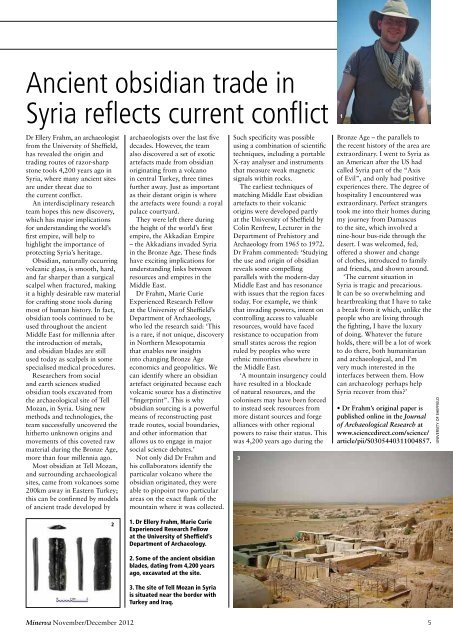Following Odysseus Not the end of the world Amarna city of light ...
Following Odysseus Not the end of the world Amarna city of light ...
Following Odysseus Not the end of the world Amarna city of light ...
- No tags were found...
Create successful ePaper yourself
Turn your PDF publications into a flip-book with our unique Google optimized e-Paper software.
Ancient obsidian trade inSyria reflects current conflictDr Ellery Frahm, an archaeologistfrom <strong>the</strong> University <strong>of</strong> Sheffield,has revealed <strong>the</strong> origin andtrading routes <strong>of</strong> razor-sharpstone tools 4,200 years ago inSyria, where many ancient sitesare under threat due to<strong>the</strong> current conflict.An interdisciplinary researchteam hopes this new discovery,which has major implicationsfor understanding <strong>the</strong> <strong>world</strong>’sfirst empire, will help tohigh<strong>light</strong> <strong>the</strong> importance <strong>of</strong>protecting Syria’s heritage.Obsidian, naturally occurringvolcanic glass, is smooth, hard,and far sharper than a surgicalscalpel when fractured, makingit a highly desirable raw materialfor crafting stone tools duringmost <strong>of</strong> human history. In fact,obsidian tools continued to beused throughout <strong>the</strong> ancientMiddle East for millennia after<strong>the</strong> introduction <strong>of</strong> metals,and obsidian blades are stillused today as scalpels in somespecialised medical procedures.Researchers from socialand earth sciences studiedobsidian tools excavated from<strong>the</strong> archaeological site <strong>of</strong> TellMozan, in Syria. Using newmethods and technologies, <strong>the</strong>team successfully uncovered <strong>the</strong>hi<strong>the</strong>rto unknown origins andmovements <strong>of</strong> this coveted rawmaterial during <strong>the</strong> Bronze Age,more than four millennia ago.Most obsidian at Tell Mozan,and surrounding archaeologicalsites, came from volcanoes some200km away in Eastern Turkey;this can be confirmed by models<strong>of</strong> ancient trade developed byarchaeologists over <strong>the</strong> last fivedecades. However, <strong>the</strong> teamalso discovered a set <strong>of</strong> exoticartefacts made from obsidianoriginating from a volcanoin central Turkey, three timesfur<strong>the</strong>r away. Just as importantas <strong>the</strong>ir distant origin is where<strong>the</strong> artefacts were found: a royalpalace courtyard.They were left <strong>the</strong>re during<strong>the</strong> height <strong>of</strong> <strong>the</strong> <strong>world</strong>’s firstempire, <strong>the</strong> Akkadian Empire– <strong>the</strong> Akkadians invaded Syriain <strong>the</strong> Bronze Age. These findshave exciting implications forunderstanding links betweenresources and empires in <strong>the</strong>Middle East.Dr Frahm, Marie CurieExperienced Research Fellowat <strong>the</strong> University <strong>of</strong> Sheffield’sDepartment <strong>of</strong> Archaeology,who led <strong>the</strong> research said: ‘Thisis a rare, if not unique, discoveryin Nor<strong>the</strong>rn Mesopotamiathat enables new insightsinto changing Bronze Ageeconomics and geopolitics. Wecan identify where an obsidianartefact originated because eachvolcanic source has a distinctive“fingerprint”. This is whyobsidian sourcing is a powerfulmeans <strong>of</strong> reconstructing pasttrade routes, social boundaries,and o<strong>the</strong>r information thatallows us to engage in majorsocial science debates.’<strong>Not</strong> only did Dr Frahm andhis collaborators identify <strong>the</strong>particular volcano where <strong>the</strong>obsidian originated, <strong>the</strong>y wereable to pinpoint two particularareas on <strong>the</strong> exact flank <strong>of</strong> <strong>the</strong>mountain where it was collected.Such specifi<strong>city</strong> was possibleusing a combination <strong>of</strong> scientifictechniques, including a portableX-ray analyser and instrumentsthat measure weak magneticsignals within rocks.The earliest techniques <strong>of</strong>matching Middle East obsidianartefacts to <strong>the</strong>ir volcanicorigins were developed partlyat <strong>the</strong> University <strong>of</strong> Sheffield byColin Renfrew, Lecturer in <strong>the</strong>Department <strong>of</strong> Prehistory andArchaeology from 1965 to 1972.Dr Frahm commented: ‘Studying<strong>the</strong> use and origin <strong>of</strong> obsidianreveals some compellingparallels with <strong>the</strong> modern-dayMiddle East and has resonancewith issues that <strong>the</strong> region facestoday. For example, we thinkthat invading powers, intent oncontrolling access to valuableresources, would have facedresistance to occupation fromsmall states across <strong>the</strong> regionruled by peoples who wereethnic minorities elsewhere in<strong>the</strong> Middle East.‘A mountain insurgency couldhave resulted in a blockade<strong>of</strong> natural resources, and <strong>the</strong>colonisers may have been forcedto instead seek resources frommore distant sources and forgealliances with o<strong>the</strong>r regionalpowers to raise <strong>the</strong>ir status. Thiswas 4,200 years ago during <strong>the</strong>31Bronze Age – <strong>the</strong> parallels to<strong>the</strong> recent history <strong>of</strong> <strong>the</strong> area areextraordinary. I went to Syria asan American after <strong>the</strong> US hadcalled Syria part <strong>of</strong> <strong>the</strong> “Axis<strong>of</strong> Evil”, and only had positiveexperiences <strong>the</strong>re. The degree <strong>of</strong>hospitality I encountered wasextraordinary. Perfect strangerstook me into <strong>the</strong>ir homes duringmy journey from Damascusto <strong>the</strong> site, which involved anine-hour bus-ride through <strong>the</strong>desert. I was welcomed, fed,<strong>of</strong>fered a shower and change<strong>of</strong> clo<strong>the</strong>s, introduced to familyand fri<strong>end</strong>s, and shown around.‘The current situation inSyria is tragic and precarious.It can be so overwhelming andheartbreaking that I have to takea break from it which, unlike <strong>the</strong>people who are living through<strong>the</strong> fighting, I have <strong>the</strong> luxury<strong>of</strong> doing. Whatever <strong>the</strong> futureholds, <strong>the</strong>re will be a lot <strong>of</strong> workto do <strong>the</strong>re, both humanitarianand archaeological, and I’mvery much interested in <strong>the</strong>interfaces between <strong>the</strong>m. Howcan archaeology perhaps helpSyria recover from this?’• Dr Frahm’s original paper ispublished online in <strong>the</strong> Journal<strong>of</strong> Archaeological Research atwww.sciencedirect.com/science/article/pii/S0305440311004857.University <strong>of</strong> sheffield21. Dr Ellery Frahm, Marie CurieExperienced Research Fellowat <strong>the</strong> University <strong>of</strong> Sheffield’sDepartment <strong>of</strong> Archaeology.2. Some <strong>of</strong> <strong>the</strong> ancient obsidianblades, dating from 4,200 yearsago, excavated at <strong>the</strong> site.3. The site <strong>of</strong> Tell Mozan in Syriais situated near <strong>the</strong> border withTurkey and Iraq.Minerva November/December 20125
















